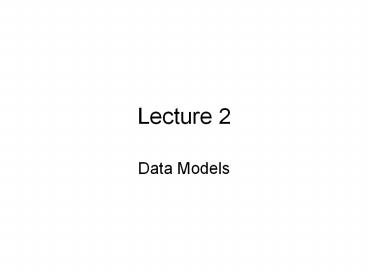Data%20Models PowerPoint PPT Presentation
Title: Data%20Models
1
Lecture 2
- Data Models
2
Learning Objectives
- Why data models are important
- About the basic data-modeling building blocks
- What business rules are and how they affect
database design - How the major data models evolved, and their
advantages and disadvantages - How data models can be classified by level of
abstraction
3
- Data model
- Models abstraction of real-world Events
- DB Model
- Represents data structure and relationship
- Conceptual
- "What" is represented
- Implementation
- "How" represented
4
CONCEPTUAL
- 3 types of associations
- ..one to many
- ..many to many
- ..one-to-one
5
Implementation
- How data is represented in database ?
6
Types of Data Models
- Hierarchical (see page 33)
- Network (see page 34)
- ..Simple
- ..Complex
- Relational (page 36)
- Object-Oriented (page 41)
7
Hierarchical DB Model
- ex IMS by IBM
- basic unit is SEGMENT
- (similar to a record)
- root
- ..a child can have at the most one parent
- ..a parent can have many children
- navigation path
- .pre order traversing
- .post order traversing
8
Advantages/Disadvantages
- Advtg
- allows data sharing
- data independence
- data integrity
- efficient for
- DISADVTG
- need to know some PHYSICAL level details
- data that do not conform to 1m
- complex and less flexible
- need to provide navigational path
- ad-hoc capabilities limited
9
Network DB model
- SET
- OWNER and MEMBERS
10
Advantages/Disadvantages
- Advantages
- .mn easy to implement
- .data integrity is maintained
- .data independence
- Disadvantages
- .Complex
- .no structural independence
- .navigation path
11
Relational Model (p 36)
- Linking relational tables (page 37)
- Typically done through primary and foreign key
- Read the examples carefully
12
Object-Oriented Model (page 41)
- Objects are defined (similar to entities)
- Objects contain data and procedures
- Objects can FIT with other objects
- Objects are reusable
- Objects have INHERITANCE property
13
ER Data Model (page 38)
- Define
- Entities
- Attributes
- Relationships
14
Degree of DATA abstraction
- Conceptual IT (hardware/software independent)
- Internal (DBMS dependent)
- External (end user orientation)
- Physical Model (actual implementation)
15
- Supplemental reading
- www.itpapers.com
PowerShow.com is a leading presentation sharing website. It has millions of presentations already uploaded and available with 1,000s more being uploaded by its users every day. Whatever your area of interest, here you’ll be able to find and view presentations you’ll love and possibly download. And, best of all, it is completely free and easy to use.
You might even have a presentation you’d like to share with others. If so, just upload it to PowerShow.com. We’ll convert it to an HTML5 slideshow that includes all the media types you’ve already added: audio, video, music, pictures, animations and transition effects. Then you can share it with your target audience as well as PowerShow.com’s millions of monthly visitors. And, again, it’s all free.
About the Developers
PowerShow.com is brought to you by CrystalGraphics, the award-winning developer and market-leading publisher of rich-media enhancement products for presentations. Our product offerings include millions of PowerPoint templates, diagrams, animated 3D characters and more.

